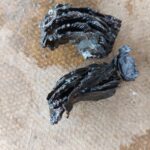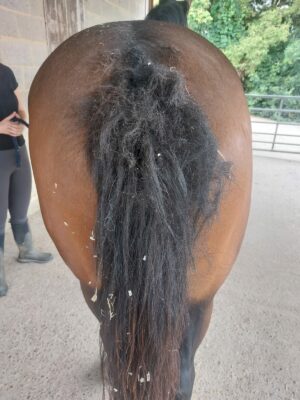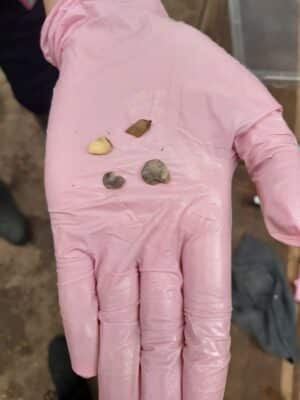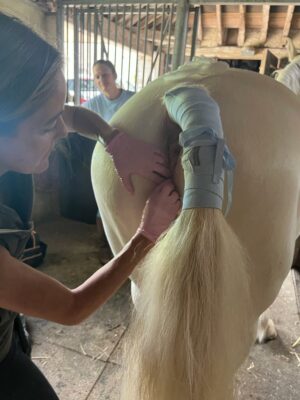Behaviour, Daily Management, Featured, Veterinary
Talking all things equine hygiene – the mares
‘Who knew mares can get beans too – could this be why your mare is rubbing her tail?’
The Horse Hub had a day out with two very experienced professional equine hygienists, Allie Macleod The Horsebox Spa and Kat Seeman Southern Equine Sheath Cleaning, to find out why we need to look after our horses’ most personal places.
Hygiene checks are essential for a mare’s comfort and performance. While most owners will check between the teats now and again and remove the hard waxy build-up that accumulates here, this is generally as far as hygiene goes for most mares.

The accumulation of hard sharp dead skin between the teats can rub and pinch, causing considerable discomfort. However, this is often the last place people think to look, if their mare is not moving well behind. It is also frequently missed as part of a horse’s grooming routine.
Allie Macleod comments: “We often hear mare owners referring to sheath cleaning and saying they are glad they don’t own a gelding; however, a mare’s hygiene care is just as important and shouldn’t be overlooked.
Thanks to social media (and articles like this), awareness is growing as to its importance.
It makes sense that annual hygiene checks should be included as part of a mare’s health and welfare programme alongside teeth, vaccinations, and worming.”
What might be a sign your mare needs a hygiene check?

- Tail rubbing!
- Muscle tension around the loins and croup
- Kicking when touched groomed or clipped around the belly and hind legs. Discomfort around the udders causes mares to be highly protective and sensitive about being touched in that area
- Heat and swelling around the teats and udders
- Bucking (especially transition into canter or when jumping)
- General grouchy behaviour
What happens during a visit?
Each horse is registered and a history taken, noting any behavioural issues or problems that may need to be tracked for future visits.
Horses are always best treated where they feel most relaxed so, once this has been established the kit needed for the visit is prepared. As with the boys, it is vital to take time to establish a rapport with the horse and to gauge how she will react to a check and treatment.
- When the horse is settled an initial check is made under the tail for sores, cuts, lumps, and bumps, then a clean tail bandage is applied.
- Bio security is vital at every step; every horse has a fresh tail bandage and new gloves are used for each procedure, along with single use syringes and sponges.
- The udders and teats are cleaned using a water-based lubricant. Mares typically build up hard crustation (dead skin, sweat, oil secretions and dirt) between their teats, which can make them very sensitive so, it is essential to treat this gently and not to pull it away. Once the build-up has been removed, it is rinsed using warm water and a new sponge.
- Next the area between the hind legs is cleaned using the same process – mares get the same build up here as they do around their udders.
- Once these areas have been cleaned, they are checked for heat and swelling around the teats, and felt for lumps, bumps, lesions, lacerations and any abnormalities.
- The dock and vulva are cleaned using water-based lubricant, unscented baby wipes and warm water.
- Mares build up dirt in the folds and creases around the vulva. Lubricant helps to soften to the dirt; the baby wipes allow a finger to be gently swiped around the folds to remove any dirt, before flushing with warm water from a syringe.
 The health check
The health check
To avoid contamination when performing the internal health check, used gloves and sponges are disposed of and replaced with new ones
- The vaginal walls are examined for colour, evidence of inflammation, tumours, sores and lacerations
- Many mares rub their tails if they have a bean or dirt between their teats. If they rub on fences and wooden stables there may also be internal splinters.
Checking a mare for a bean
Some mares find this part of the procedure sensitive and can kick so care is always taken to stand to the side.
- Mare beans are found inside the clitoris and clitoral fossa. They are typically the size of a pumpkin seed. Although small they can be the source of considerable irritation.
- A small amount of lubricant is applied to the clitoral sinuses (the central and 2 lateral).
- It is not always obvious if a mare has a bean as the clitoris is very fleshy and the beans can be very small – they can be found about a centimetre deep within the clitoris so very gentle manipulation is needed.
- Once removed, the clitoris is flushed with a very small amount of warm water (20mls) taking care not to flush inside the vagina.

The notes from the treatment are documented and owners are provided with a health card for their records. Any abnormalities that may be a cause of concern are discussed, and where appropriate veterinary intervention is suggested.
Can I check my mare myself?
Yes absolutely! Certainly, the care around the udders, dock and vulva providing it can be done safely, without the risk of being kicked.
Mares tend to build up crustations quite quickly so it’s important for owners to carry out this basic care themselves to keep the mare comfortable.
It is recommended that health checking and bean removal should be performed annually by a professional hygienist or vet annually.
Further reading: All things equine hygiene – the boys
THE BRITISH EQUINE HYGIENISTS ASSOCIATION
 Did you know there is now an organisation to ensure whoever you have out to make sure your horse’s personal places are clean and comfortable, is working to the highest professional standards?
Did you know there is now an organisation to ensure whoever you have out to make sure your horse’s personal places are clean and comfortable, is working to the highest professional standards?
The British Equine Hygienists Association is a consortium of equine hygienists who are scrupulous about bio security and hygiene standards, are fully insured and, undertake CPD to continue their learning and understanding of our horses most sensitive areas. Find them here

 The health check
The health check